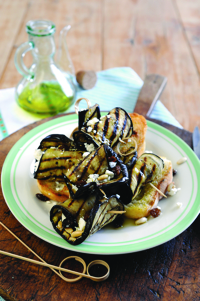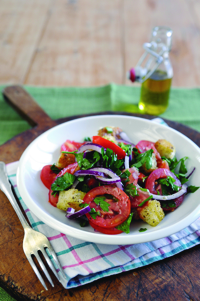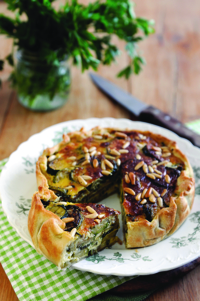The orto is the Italian vegetable garden, an essential part of the fresh food culture. Mario Matassa digs his last seasonal treats, and shares his homegrown Italian recipes…
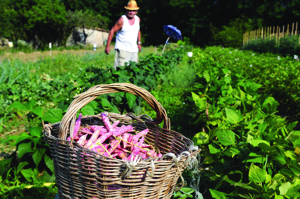 There’s an old man in a string vest with a worn and battered straw hat tending to neat rows of tomatoes. Wicker baskets, filled to the brim with borlotti beans, await collection. An old dust sheet is laid out on the pavement, covered from one end to the next with onions left out to dry a little in the hot sun before being stored in the cantina for the winter. Though it may seem a stereotype, it’s a scene that is played out throughout Italy over the summer months.
There’s an old man in a string vest with a worn and battered straw hat tending to neat rows of tomatoes. Wicker baskets, filled to the brim with borlotti beans, await collection. An old dust sheet is laid out on the pavement, covered from one end to the next with onions left out to dry a little in the hot sun before being stored in the cantina for the winter. Though it may seem a stereotype, it’s a scene that is played out throughout Italy over the summer months.
From early spring through to mid autumn, Italians of all ages take to their vegetable gardens (orto) with determination and enthusiasm. While grow-your-own is currently experiencing something of a renaissance in Britain, in Italy the demand for home-grown produce has always been high. The orto in Italian society is a veritable institution – it always has been that way and it probably always will be. Growing your own food is so axiomatic that it is virtually assumed that if you have some space – and it doesn’t require much – over the summer months you will be harvesting your own produce.
The Italian orto is, in many senses, a reflection of Italian society. What grows in one orto will very much depend on local regional preferences and tastes. But there are some national trends. For example, the Holy Trinity of the orto consists of tomatoes, courgettes and salad. These are the entry-level staples of the Italian vegetable gardener. Everyone grows them, though the varieties will differ between regions.
The more gifted, and those with the luxury of extra space, will also grow – among other things – peppers, aubergines, garlic, potatoes, onions, pumpkins, beans and various varieties of fresh herbs. Popular seasonal fruits include delicious watermelons and strawberries. Peach, apple, plum, apricot, fig and pear trees are also commonplace, with the added bonus that when strategically situated they provide much needed shade during hot summer days.
Italians eat direct from the orto over the summer months. Whether it’s the ingredients for the evening bowl of minestrone, a plate of pasta with summer vegetables, a pumpkin risotto, a peach soaked in red wine or just a simple mixed salad, the likelihood is that everything needed will be picked just moments before preparation. What’s not used immediately is preserved and set aside for the winter months – in jams and pickles or frozen for future meals. And almost invariably there will be still more food left over. This finds its way into the grateful hands of any number of family, friends and neighbours who will appreciate a taste of your efforts.
…………………………………………..
Involtini di melanzane
Serves 4 | Preparation 20 mins | Cooking 15 mins
2 long aubergines
2 tbsp toasted pine nuts
6 tbsp golden sultanas
100g feta cheese
Salt and pepper
Olive oil
Slices of toasted bruschetta for serving
Slice the aubergines lengthways about ½cm in thickness. Brush the aubergine slices with a little olive oil and cook on a hot griddle pan for 5-6 minutes until tender. When cooked, remove from the heat and set aside to cool.
Once cool, take a slice of aubergine and add a few pine nuts, sultanas and crumbled feta cheese on top. Roll the slice up and secure with a toothpick. Continue with this process until all the ingredients are rolled into the aubergines.
To serve, simply place the aubergine rolls on top of toasted bruschetta and drizzle generously with good olive oil.
…………………………………………..
Insalata di pomodori e cipolle
Serves 4 | Preparation 10 mins | Cooking 7 mins
250g tomatoes
1 small red onion
3 slices of rustic, day-old bread
Small bunch of parsley
Extra virgin olive oil
1 garlic clove
Red wine vinegar
Salt and pepper
Chop the slices of bread into 1cm cubes. Place 3 tbsp olive oil and the crushed garlic clove into a large heavy-based frying pan. When the oil is hot add the bread and toss. Turn down the heat and continue cooking until crispy. When done, remove the croutons from the pan and set aside. Finely dice the onion, slice the tomatoes and roughly chop the parsley and place these into a serving bowl. Mix well.
When ready to serve add the croutons. Dress the salad with plenty of extra virgin olive oil, a little red wine vinegar and add a seasoning of salt and pepper to taste.
…………………………………………..
Torta salata con zucchini e pinoli
Serves 4 | Preparation 10 mins | Cooking 45 mins
4 medium sized courgettes
2 free range eggs
60g freshly grated Parmesan
2 tbsp toasted pine nuts
1 sheet savoury shortcrust pastry
Olive oil
Dried oregano
Salt and pepper
Slice the courgettes into ½cm rounds. Place a few tbsp olive oil into a large frying pan and add the courgettes (in batches if necessary). Cook them for 5-6 minutes, stirring frequently, until golden.
Remove the courgettes from the pan and set aside. Line a round 22cm baking tin with the shortcrust pastry and place in the fridge while you prepare the filling.
Place the eggs into a bowl and add the cheese, toasted pine nuts, 1 tsp oregano and salt and pepper. Stir together well and then add the courgettes and stir these through also. Spoon the filling into the pastry case and bake in a preheated oven at 180°C/350ºF/Gas Mark 4 for 30-35 minutes. Once cooked, remove the tart from the oven and set aside to cool. Serve at room temperature.
…………………………………………..
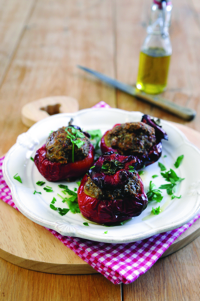 Roast stuffed mini bell peppers
Roast stuffed mini bell peppers
Peperoni ripieni
Serves 4 | Preparation 15 mins | Cooking 50 mins
8 mini bell peppers
300g beef mince
6 tbsp fresh breadcrumbs
1 free range egg
60g freshly grated Parmesan cheese
Small bunch of parsley
Olive oil
Salt and pepper
Add 1 tbsp olive oil to a frying pan and when hot add the beef mince. Cook for 5-6 minutes until browned. Season the mince with salt and pepper and place into a bowl. Add the breadcrumbs, cheese and a few tbsp finely chopped parsley. Slightly whisk the egg and add this to the mix. Mix everything together well.
To prepare the peppers, carefully remove the top of each pepper by cutting a circle around the stalk. Gently pull the lid off the pepper and remove the seeds from inside.
Finally, take the beef mixture and spoon this generously into the cavity of each pepper. Then place the peppers on a baking tray, drizzle with a little olive oil and bake in a preheated oven at 170°C/325ºF/Gas Mark 3 for 40-45 minutes.

